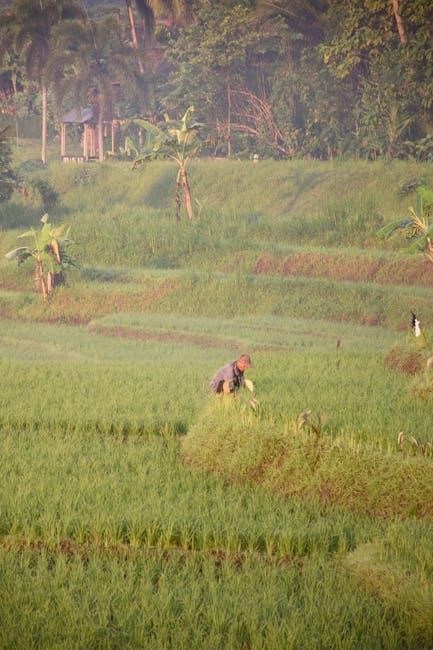The Nikon D7200 Instruction Manual is your gateway to mastering this powerful DSLR camera. It covers essential features, shooting modes, and customization options to enhance your photography experience.
1.1 Overview of the Nikon D7200 Camera
The Nikon D7200 is a high-performance DSLR camera designed for enthusiasts and professionals. It features a 24.1-megapixel DX-format APS CMOS sensor, delivering exceptional image quality and detail. The EXPEED 4 image processor ensures fast operation and efficient noise reduction. With an ISO range of 100 to 25600, the camera excels in low-light conditions. It supports Full HD video recording and offers advanced autofocus and metering systems. The D7200 also includes built-in Wi-Fi and NFC for seamless connectivity. Its durable construction and intuitive controls make it a versatile tool for capturing stunning stills and videos in various settings.
1.2 Importance of Reading the Instruction Manual
Reading the Nikon D7200 instruction manual is crucial for unlocking the camera’s full potential. It provides detailed insights into features like the 24.1-megapixel sensor and EXPEED 4 processor. Understanding ISO ranges, autofocus systems, and video capabilities ensures better control. The manual also covers customization options and maintenance tips, such as cleaning the sensor and updating firmware. By familiarizing yourself with the guide, you can optimize settings for various shooting conditions, troubleshoot common issues, and enhance your photography skills. It serves as an essential resource for both beginners and experienced users, helping to maximize the camera’s performance and versatility in different creative scenarios.

Accessing the Nikon D7200 Instruction Manual
The Nikon D7200 manual is available as a PDF download, via the Nikon Manual Viewer 2 app, or through the official Nikon website and other online platforms.
2.1 Downloading the PDF Manual
The Nikon D7200 instruction manual can be easily downloaded as a PDF from Nikon’s official website or trusted sources like ManualsLib. Visit the Nikon support page, select your camera model, and navigate to the “Manuals” section. Click on the PDF link to download the file, which is compatible with Adobe Acrobat Reader. This format allows for offline access and easy navigation. The PDF manual includes detailed instructions, specifications, and troubleshooting tips to help you make the most of your camera. Ensure you download from official or reputable sites to avoid unauthorized content.
2.2 Using the Nikon Manual Viewer 2 App
The Nikon Manual Viewer 2 app offers a convenient way to access the D7200 manual on your smartphone or tablet. Available for free on the App Store and Google Play, this app allows you to view detailed instructions anytime, anywhere. It provides an interactive experience, enabling you to search for specific features or troubleshooting tips. The app is particularly useful for understanding camera functions without carrying the physical manual. Offline access ensures you can review settings even without internet connectivity, making it an essential tool for photographers on the go who need quick guidance.
2.3 Quick Setup Guide
The Quick Setup Guide for the Nikon D7200 is designed to help you get started quickly. It covers the basics of camera assembly, battery charging, and initial settings. This concise guide walks you through mounting the lens, inserting the memory card, and setting the date and time. It also provides an overview of the camera’s exterior controls, ensuring you understand the essential buttons and dials. The guide is perfect for new users who want to begin shooting without diving into the full manual. It simplifies the setup process, allowing you to capture stunning images right away.

Camera Specifications and Features
The Nikon D7200 boasts a 24.1MP DX-format APS CMOS sensor, EXPEED 4 processor, and wide ISO range, delivering exceptional image quality and performance in various conditions.
3.1 24.1-Megapixel DX-Format APS CMOS Sensor
The Nikon D7200 features a 24.1-megapixel DX-format APS CMOS sensor, which captures detailed images with vibrant colors. Without an Optical Low-Pass Filter (OLPF), it enhances sharpness and clarity. This sensor works seamlessly with the EXPEED 4 image processor to deliver high-speed operation and reduced noise. The sensor’s design ensures excellent performance in low-light conditions, making it ideal for photographers seeking professional-grade results. Its ability to produce high-resolution images with minimal noise makes it a standout feature for both enthusiasts and professionals. This sensor is a key component in achieving the D7200’s remarkable image quality and versatility.
3.2 EXPEED 4 Image Processor
The EXPEED 4 image processor in the Nikon D7200 enhances image quality and processing speed. It improves noise reduction, color accuracy, and overall performance. This processor enables faster autofocus, quick continuous shooting, and efficient video recording. It also supports advanced features like Full HD video and interval shooting. The EXPEED 4 ensures smooth operation and optimal image rendering, making it a crucial component for capturing stunning photos and videos. Its advanced capabilities provide photographers with the tools needed to achieve professional results efficiently.
3.3 ISO Range and Low-Light Performance
The Nikon D7200 offers an impressive ISO range of 100 to 6400, which can be extended to 25600 for extreme low-light conditions. This versatility ensures sharp and detailed images even in dimly lit environments. The camera’s EXPEED 4 processor works to minimize noise, delivering clean results across the entire ISO spectrum. Whether capturing indoor events, nighttime landscapes, or low-light portraits, the D7200’s ISO capabilities provide consistent performance. This feature makes it an excellent choice for photographers seeking reliability in diverse lighting situations, ensuring high-quality output without compromising on detail or clarity.

Shooting Modes and Settings
The Nikon D7200 offers versatile shooting modes, including Automatic, Manual, and Custom Settings, allowing photographers to control exposure, ISO, and white balance for creative flexibility.
4.1 Automatic Mode
Automatic Mode on the Nikon D7200 simplifies photography by adjusting settings like aperture, shutter speed, and ISO for optimal results. This mode is ideal for beginners or quick shots, ensuring sharp, well-exposed images without manual adjustments. The camera automatically selects the best settings based on lighting conditions, allowing users to focus solely on composition. Additionally, features like scene detection and auto white balance enhance image quality further, making it a reliable choice for everyday photography needs.
4.2 Manual Mode
Manual Mode on the Nikon D7200 offers full creative control, allowing photographers to adjust aperture, shutter speed, and ISO independently. This mode is ideal for experienced users who want precise control over their shots. By manually setting these parameters, photographers can achieve unique artistic effects, such as shallow depth of field or motion blur. The camera’s metering system provides guidance, but the user retains complete control. Manual Mode is particularly useful in challenging lighting conditions or when a specific visual style is desired. It requires a strong understanding of exposure principles but offers unparalleled flexibility for professional-grade results.
4.3 Custom Settings
Custom Settings on the Nikon D7200 allow users to tailor camera functions to their preferences, enhancing workflow efficiency. These settings include options for autofocus, metering, and exposure controls, enabling photographers to adapt the camera to specific shooting styles. By saving custom configurations, users can quickly access their preferred setups, reducing time spent on adjustments during shoots. This feature is particularly beneficial for professionals who require consistent results across different projects. Custom Settings empower photographers to personalize their camera, ensuring a seamless and intuitive shooting experience tailored to their creative vision and technical requirements.

Autofocus and Metering
The Nikon D7200 features an advanced autofocus system and multiple metering modes, ensuring precise focus and accurate exposure for exceptional image quality and control.
5.1 Autofocus System
The Nikon D7200 boasts a sophisticated autofocus system, utilizing 51 focus points with 15 cross-type sensors for enhanced accuracy and speed. This system excels in various lighting conditions, capturing sharp images even in low-light environments. The camera also offers dynamic autofocus modes, allowing seamless tracking of moving subjects. Additionally, the D7200 supports custom autofocus settings, enabling photographers to tailor focus behavior to their specific needs. These features collectively ensure precise control over focus acquisition, making the D7200 ideal for both still photography and dynamic action shots.
5.2 Metering Modes
The Nikon D7200 offers three primary metering modes to ensure accurate exposure control. The Matrix Metering mode analyzes the entire scene, considering brightness, color, and composition for balanced results. Center-weighted Metering prioritizes the central area of the frame, ideal for portraits. Spot Metering measures a small, specific area, perfect for high-contrast lighting. These modes adapt to various shooting conditions, providing flexibility for photographers to achieve their desired exposure outcomes. By understanding and utilizing these metering options, users can enhance their creative control and capture images with precision.

ISO and Noise Reduction
The Nikon D7200 features an ISO range of 100 to 6400, extendable to 25600, ensuring excellent low-light performance. Noise reduction techniques help maintain image quality at higher sensitivities.
6.1 Understanding ISO Sensitivity
ISO sensitivity in the Nikon D7200 determines how sensitive the camera’s sensor is to light. Lower ISO values (100-400) are ideal for bright conditions, minimizing noise and ensuring sharp images. Higher ISOs (800-6400) are best for low-light situations, allowing you to capture images without a flash, though they may introduce grain. The D7200’s extended ISO range up to 25600 offers flexibility in challenging lighting, making it suitable for various photography scenarios while maintaining image quality through advanced noise reduction algorithms.
6.2 Managing Noise Reduction
The Nikon D7200 features advanced noise reduction capabilities to optimize image quality, especially in low-light conditions. The camera offers both Long Exposure NR and High ISO NR settings, which can be adjusted based on your needs. Long Exposure NR helps reduce noise in images taken with exposures longer than one second, while High ISO NR minimizes grain when shooting at elevated ISO sensitivities. These settings can be customized in the camera’s menu, allowing you to balance noise reduction with image sharpness. Properly managing these features ensures clearer and more professional-looking photos across various lighting environments.

Video Recording Capabilities
The Nikon D7200 supports Full HD 1080p video recording at 60fps, offering smooth motion and detailed footage. Manual controls allow precise adjustments for professional-grade video production.
7;1 Full HD Video Recording
The Nikon D7200 excels in Full HD video recording, capturing stunning 1080p footage at 60fps. This feature ensures smooth motion and crisp details, ideal for dynamic scenes. The camera’s EXPEED 4 processor enhances video quality by reducing noise and artifacts, delivering professional-grade results. Users can manually adjust settings like aperture, shutter speed, and ISO during recording, providing creative control. Additionally, the D7200 supports external microphones, allowing for high-quality audio to complement the video. This capability makes the D7200 a versatile tool for videographers seeking precise control and exceptional output in various shooting conditions.
7.2 Video Autofocus and Stabilization
The Nikon D7200 offers advanced autofocus capabilities during video recording, ensuring sharp focus even in dynamic scenes. Its contrast-detection AF system provides smooth and accurate tracking of subjects. Additionally, the camera supports external microphones for high-quality audio, enhancing the overall video experience. The D7200 also features electronic vibration reduction (EVR), which stabilizes footage to minimize camera shake. This feature is particularly useful for handheld shooting or when using non-stabilized lenses. With these tools, the D7200 delivers professional-grade video performance, making it ideal for capturing crisp, stable, and well-focused content in various shooting conditions.

Advanced Features
The Nikon D7200 boasts advanced features like a weather-sealed body, dual SD card slots, and RAW image capture. Its built-in flash commander mode enhances external lighting control, while the 51-point autofocus system ensures precise subject tracking, making it a versatile tool for professional photographers.
8.1 Built-In Wi-Fi and NFC
The Nikon D7200 features built-in Wi-Fi and NFC capabilities, enabling seamless connectivity with smartphones and tablets. Users can transfer images wirelessly, share content instantly, and remotely control the camera using the Nikon WMU app. NFC allows for quick pairing with compatible devices, simplifying the connection process. This functionality enhances workflow efficiency and provides greater convenience for photographers on-the-go. The Wi-Fi capabilities support fast image transfer, while the app enables remote shooting, focusing, and adjustments, making it an indispensable tool for modern photography needs and sharing experiences.
8.2 Time-Lapse Photography
The Nikon D7200 supports time-lapse photography, allowing users to capture dynamic scenes by shooting sequences of images at set intervals. This feature is ideal for documenting events like sunsets, cloud movements, or plant growth. The built-in interval timer enables photographers to specify the number of shots and intervals, with options ranging from seconds to hours. The resulting images can be combined into a time-lapse video using Nikon’s software or third-party tools. This mode is accessed through the Shooting Menu, offering flexibility and creativity for capturing unique and engaging visual content with ease and precision.
8.3 Interval Shooting
Interval shooting on the Nikon D7200 allows photographers to capture images at predetermined intervals, ideal for observing changes over time. Accessible via the Shooting Menu, this feature enables users to specify the number of intervals and the duration between shots. It is particularly useful for projects like time-lapse photography, where consistent image capture is essential. The camera automatically shoots the set number of images, providing a comprehensive record of the subject’s evolution. This feature is perfect for documenting growth, weather patterns, or any scenario requiring sequential image capture with minimal manual intervention.

Customization and Personalization
The Nikon D7200 offers extensive customization options, allowing users to tailor settings to their preferences. Personalize menu options, assign functions to buttons, and save custom configurations for quick access.
9.1 Custom Menu Options
The Nikon D7200’s custom menu options enable photographers to streamline their workflow by creating personalized settings. Users can organize frequently used functions into a custom menu, ensuring quick access during shoots. This feature is particularly useful for professionals who need to adjust settings rapidly. Additionally, the ability to save custom configurations allows for consistent results across different shooting scenarios. By tailoring the menu to individual preferences, photographers can enhance efficiency and focus more on creativity. This level of customization underscores the D7200’s versatility for diverse photographic needs and styles.
9.2 Assigning Functions to Buttons
The Nikon D7200 allows photographers to assign custom functions to specific buttons, enhancing usability and efficiency. This feature lets users tailor the camera to their shooting style, reducing the need to navigate through menus. Common functions like ISO adjustment, white balance, or focus mode can be assigned to buttons such as the Fn or AE-L/AF-L buttons. This customization streamlines workflow, enabling quick access to frequently used settings. By personalizing button assignments, photographers can optimize their shooting experience, making the camera an extension of their creative process. This level of control is particularly beneficial for professionals and enthusiasts seeking precision and speed.
9.3 Saving Custom Settings
Saving custom settings on the Nikon D7200 ensures that your personalized configurations are preserved for future use. This feature is especially useful for photographers who work in consistent environments or specific genres, allowing them to quickly recall their preferred setup. The camera offers multiple slots for saving different configurations, making it easy to switch between setups for various shooting scenarios. By saving these settings, users can maintain consistency and efficiency, avoiding the need to reconfigure the camera each time. This functionality enhances workflow and ensures that photographers can focus on capturing the perfect shot without unnecessary distractions. Saving custom settings is a practical tool for streamlining your photography process.

Maintenance and Troubleshooting
Regular maintenance and troubleshooting ensure optimal performance and longevity of your Nikon D7200. Clean the sensor, update firmware, and address common issues promptly for reliable operation.
10.1 Cleaning the Camera Sensor
Cleaning the Nikon D7200’s sensor is crucial for maintaining image quality. Turn on Mirror Lock-Up to access the sensor. Use a soft-bristled brush or compressed air to remove dust. Avoid touching the sensor with bare hands or using liquids, which can damage it. For stubborn spots, use a swab with a cleaning solution specifically designed for sensors. Always refer to the manual for detailed instructions to ensure safe and effective cleaning without causing damage to the sensor or camera internals.
10.2 Updating Firmware
Updating the Nikon D7200’s firmware ensures optimal performance and adds new features. Visit Nikon’s official website to download the latest firmware version. Use a fully charged battery or connect the camera to a power source. Copy the firmware file to a memory card and follow the on-screen instructions in the camera’s menu. Avoid interrupting the update process to prevent damage. After completion, restart the camera to apply the changes. Regularly check for updates to benefit from improvements and enhanced functionality. Always use official Nikon sources to ensure compatibility and safety during the firmware update process.